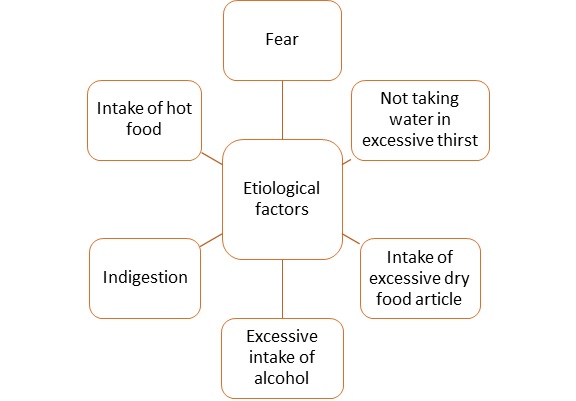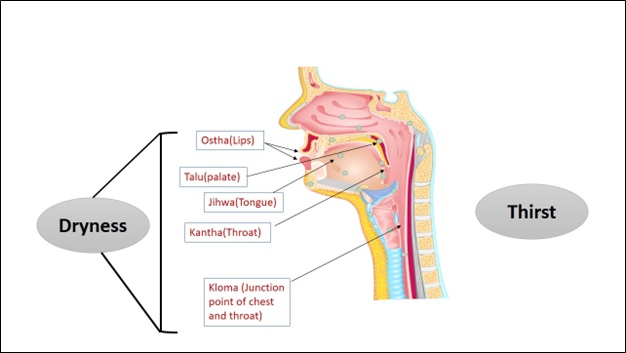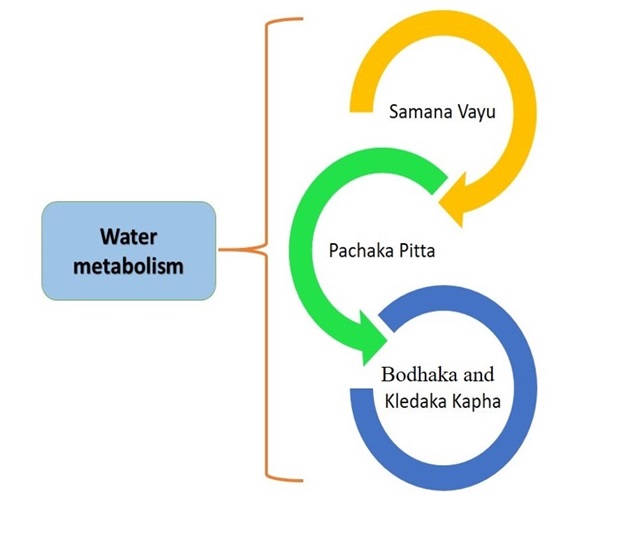Difference between revisions of "Udakavaha srotas"
| Line 75: | Line 75: | ||
,,,Signs and symptoms of srotas injury(srotoviddha Lakshana)''' | ,,,Signs and symptoms of srotas injury(srotoviddha Lakshana)''' | ||
| − | <p style="text-align:justify;">Acharya Sushruta defined the clinical signs and symptoms related to injury or trauma to the udakavahasrotas <ref name="ref5" | + | <p style="text-align:justify;">Acharya Sushruta defined the clinical signs and symptoms related to injury or trauma to the udakavahasrotas <ref name="ref5" />[Su. Sa. Sharira Sthana 09/12] Signs and symptoms of injury (srotoviddha) are: |
1. Excessive thirst (pipasa) | 1. Excessive thirst (pipasa) | ||
2. Sudden death (sdayomarana) | 2. Sudden death (sdayomarana) | ||
Revision as of 18:23, 3 November 2023
Udaka means water. In body, water is present in the form of various fluids. Udakavaha srotasa are the channels for transport and transformation of fluid (water) and its circulation. They are the pathways that originate from the palate (talu) or kloma (an internal organ controlling thirst) through which fluids circulate throughout the body. [Code:SAT-B.475][1] A water-based solution of ions and other compounds makes up most of the adult human body's 60% fluid content. Water makes up most of a cell's primary fluid medium except fat cells. It is present in most cells at a concentration of between 70 and 85 percent.[2]The human body uses water as a construction material, a lubricant, a shock absorber, a solvent, a reaction medium, and a reactant. It also serves as a transporter for nutrients and waste products. Water balance must be managed for the preservation of health and life.[3] So udakavaha srotas are the channels for regulating the water homeostasis in the human body, and failure to do the same can lead to death. This article deals with physiological, pathological and therapeutic aspects of udakavaha srotasa.
| Section/Chapter/topic | Concepts/SrotasUdakavaha Srotas |
|---|---|
| Authors | Bhojani M. K. 1, Tanwar Ankur Kumar 1 |
| Reviewer | Basisht G.2 |
| Editor | Deole Y.S.3 |
| Affiliations |
1 Department of Sharir Kriya, All India Institute of Ayurveda, New Delhi, India 2 Rheumatologist, Orlando, Florida, U.S.A. 3 Department of Kayachikitsa, G. J. Patel Institute of Ayurvedic Studies and Research, New Vallabh Vidyanagar, Gujarat, India |
| Correspondence emails |
meera.samhita@aiia.gov.in, carakasamhita@gmail.com |
| Publisher | Charak Samhita Research, Training and Development Centre, I.T.R.A., Jamnagar, India |
| Date of publication: | October 10, 2023 |
| DOI | 10.47468/CSNE.2023.e01.s09.156 |
Etymology and derivation:
The word udaka is derived from root “undi kledane”.[4] It implies that thing which is to wet is udaka.
The word srotas is derived from Sanskrit root “sru”.[4] Meaing of sru is to secrete, to flow. Acharya sushruta defines srotas as tubular structures through which fluid material circulates in the body.[5][Su. Sa. Sharira Sthana 09/13] Dalhana mentioned two important characteristics of srotas: 1. Passage for fluid (abhivahanshila) and 2. Hollow space to flow (avakash).[5] [Dalhan on Su. Sa. ShariraSthana 09/13] Srotas, according to acharya Charak, is a structure through which anything is conveyed or flows. [Cha. Sa. Sutra Sthana 30/12] Udakavaha srotas are the channels for water regulation.
Synonyms:
Udaka: apa, vari, salil, kamal, jalam, payas, water.[4] [6]
Srotas: ambusarana,svatasan,[4]sira, dhamani, rasayani, rasavahini, nadi, pantha, marga, sharirachhidra, samritasavritta, Sthana, Ashaya, Niketa[Cha. Sa. Vimana Sthana 05/09], yogvahi[5] [Su. Sa. Sharira Sthana 05/05], a wave, the flow, a current, the canal of nutrients in the body.[6]
Udakavaha srotas: ambuvaha[Cha. Sa. Vimana Sthana 05/9] [Cha. Sa. Chikitsa Sthana 28/8], rasavahini [Cha. Sa. Chikitsa Sthana 22/06], water regulating system.
Origin (Srotomula)
Acharya described the two roots of every srotas. In context of udakavaha srotas, the roots are palate (talu) and junction of throat & chest (kloma). [Cha. Sa. Vimana Sthana 05/09] [Su. Sa. Sharira Sthana 09/12][5] Acharya described these sites as root because in water imbalance, these organs first manifest the sign of thirst. The exact site of kloma is not defined but it’s the main controlling center for water regulation in the body. Acharya chakrapani described kloma as the site of thirst and mentioned that it is situated near the heart (hridyastha pipasa sthana).[Chakrapani on Cha. Sa. Vimana Sthana 05/08] Acharya Gangadhara described the site of kloma as the junction of throat and chest (Kantha urso sandhi). [Gangadhara on Cha. Sa. Vimana Sthana 05/08] The name "kloma" can be applied to mediastinum that is located at above mentioned sites.[7] Contemporary understanding of regulation of water is a feedback process involving the hypothalamus, the neurohypophysis, and the kidneys.[8]The main hormone that controls how much water the body retains is arginine vasopressin (AVP), commonly known as anti-diuretic hormone.[9]
Etiological factors behind srotas abnormalities (sroto dushti hetu)
[Cha. Sa. Vimana Sthana 05/11]These factors are:
- Intake of hot food (aushnyat)
- Indigestion (aamat)
- Fear (bhayat)
- Excessive intake of alcohol (panat)
- Intake of excessive dry food article (arishuksha anna sevanat)
- Habit of withholding the urge in excessive thirst (trishnaya cha atipidanat)
All these factors contributed in dysregulation of water regulation.
Clinical features of srotas abnormality (srotodushti lakshana)[Cha. Sa. Vimana Sthana 05/11]
1. Feeling of dryness of tongue (jihwa), palate (talu), lips (ostha), throat (kantha) and kloma. 2. Excessive thirst (pipasa)
,,,Signs and symptoms of srotas injury(srotoviddha Lakshana)
Acharya Sushruta defined the clinical signs and symptoms related to injury or trauma to the udakavahasrotas [5][Su. Sa. Sharira Sthana 09/12] Signs and symptoms of injury (srotoviddha) are: 1. Excessive thirst (pipasa) 2. Sudden death (sdayomarana)
Disorders of srotas abnormality
The diseases due to vitiation of udakavaha srotas are: 1. Prameha (Urinary diseases including diabetes) [Cha. Sa. Chikitsa Sthana 06/08] 2. Trishna (Morbid thirst)[Cha. Sa. Chikitsa Sthana 22/06] 3. Atisara (Diarrhea and associated disorders) [Cha. Sa. Chikitsa Sthana 19/05-10] 4. Visuchika (Non-infectious gastroenteritis) [Cha. Sa. Vimana Sthana 02/10-11] 5. Hikka (Hiccups)[Cha. Sa. Chikitsa Sthana 17/21] 6. Shwasa(Dyspnea) [Cha. Sa. Chikitsa Sthana 17/45] 7. Udara roga(Generalised enlargement of abdomen)[Cha. Sa. Chikitsa Sthana 13/20]
Some other diseases may be included under udakavaha stotas disorders:[10] • Edema • Hydrocephalus • Increased intracranial pressure • Diarrhea • Craving for sour and pungent food Excessive use of salt and sugar • Diabetes • Excessive thirst with dry mouth • Dry skin • Profuse sweating • Profuse urination • Glaucoma
Diagnostic and assessment tools:
The condition of udakavaha srotas can be assessed by subjective methods like questionnaires and objective methods like blood investigations etc.. Udakavaha srotodushti can be assessed through a subjective questionnaire by which an ayurvedic physicians assess the normalcy and abnormality based on ayurvedic principles of examination (pariksha). Some of the objective methods which may be used to assess the normal functioning of udakavaha srotas are: 1. Urine routine examination for specific gravity, volume, ph etc. 2. Serum electrolyte (Sodium and potassium) 3. MRI Scan for hypothalamus abnormality 4. Blood sugar for assessing the abnormality. 5. Dual-energy X-ray absorptiometry (DEXA)[11] 6. Air displacement plethysmography,[12] 7. Nuclear magnetic resonance spectroscopy [13], and 8. Bioelectrical impedance analysis [14] [15]
Treatment of srotas abnormality
The treatment for the viation of udakavaha srotas should be done on the principles of management of thirst disorder (trishna chikitsa). [Cha. Sa. Vimana Sthana 05/26]</ref> [16]The signs and symptoms of udakavaha srotas vitiation are comparable to morbid thirst (trishna), which develops as a result of vata and pitta vitiation. Because both doshas have absorbent (shoshaka) properties that degrade the rasavaha and udakavaha srotas. This leads to persistent desire for water. Rain water is the best way to quench thirst. However, nowadays rainwater is rarely stored and used for drinking. Therefore water with a mild astringent flavour, light to digest, cold characteristics, nice scent and taste, and no channel obstructing qualities should be deemed comparable to rain water in effect.[16]
Dosha governing the water metabolism
Dosha are the physiological entity in human body governing all systems. For maintenance of water balance different dosha work in synergy to each other. Acharya Charak clearly described the relation between samana vayu and ambuvaha srotas. [Cha. Sa. Chikitsa Sthana 28/8] Samana vayu is situated in swedavaha, doshavaha and ambuvaha or udakavaha srotas. It showed the samana vayu is essential for maintainance of water regulation in human body. Along with samana vayu, pitta (pachaka) and kapha (bodhaka and kledaka) also help in water homeostasis.
Future area of research
The future area of research is the preparation of a validated and standardized questionnaire for assessing the normalcy and abnormality of functioning of udakavaha srotas. Assessment of udakavaha srotas condition in various disease may be helpful in prognosis and treatment outcome. In various physiological conditions like pregnancy, lactation, childhood, old age, space, deep sea and high altitude, the udakavaha srotas assessment may be helpful to understand the dynamic changes occurred within the body. Animal studies to understand the anatomy and physiology of kloma may be helpful for future researches related to udakavaha srotas.
Thesis works:'
1. Dash Maheshwar (1985): Srotas in ayurveda with special reference to udakavaha srotras, Department of Basic Principles, B.H.U.Varanasi, India 2. Kambale V.(1997): Udakavaha srotas mulastana nischiti evam kloma tulanatmaka adhyayan, Department of sharir Rachana, Govt. Ayurveda Mahavidyalaya, Nanded.
Current researches
Contemporary understanding of udakavaha srotas: The cerebrospinal fluid, salivary amylase, and digestive/hepatobiliary system secretions such HCL, bile, pancreatic lipase, and pancreatic amylase are all included in the udaka/ambuvaha srotas. It is also associated with rasa dhatu, which provides the fluid and oiliness needed to transport the necessary nutrients, lubricate various body processes, and support thermodynamic control.[10]
Udakavaha srotas and shwasa roga:
Shwasa roga (dysnoea) occurrs due to vitiation of prana, anna and udakavaha srotas. But understanding the role of udakavaha srotas is difficult. In causative factors of shwasa (nidana), the majority causes of udakavaha srotas dushti are covered. The five varieties of shwasa exhibit its clinical features. In shwasa chikitsa, additional liquid preparations are suggested in order to correct the body's water balance. So, this review helps to understand the role of udakavaha srotas in shwasa roga.[17]
13.3 Udakavaha srotodushti with special reference to kapha dominant prameha (obstinate urinary disorders including diabetes):
In order to comprehend the notion of looseness of body components (sharira shaithilya) in the pathogenesis (samprapti) of kapha dominant prameha and to assess the application of the essential ayurveda principles of udakavaha stroto dushti, a clinical research on 40 clinically confirmed patients of kapha dominant prameha was done. The study came to the conclusion that srotodushti and pathogenic factors should be taken into account while treating diabetic patients, so that we can focus on treating sroto dushti and its root as well as the illness.[18]
Send us your suggestions and feedback on this page.
References
- ↑ National AYUSH Morbidity and Standardized Terminologies Electronic Portal by Ministry of AYUSH Available on http://namstp.ayush.gov.in/#/Ayurveda
- ↑ A. C. Guyton and J. E. Hall, Textbook of Medical Physiology. 11th edition. Pennsylvania: Elsevier Saunders, 2006.
- ↑ Jéquier E, Constant F. Water as an essential nutrient: the physiological basis of hydration. Eur J ClinNutr. 2010;64(2):115-23.
- ↑ 4.0 4.1 4.2 4.3 Amarkosha. Amarsimha, Edited by Pt. Haragovindasastri. Reprint Ed. Varanasi:Chaukhambha Sanskrit Sansthan, 2020.
- ↑ 5.0 5.1 5.2 5.3 5.4 Sushruta. SushrutaSamhita. Edited by JadavajiTrikamjiAacharya. 8th ed. Varanasi: ChaukhambhaOrientalia; 2005.
- ↑ 6.0 6.1 Monier-Williams, Monier William's Sanskrit-English Dictionary, 2nd Ed., Oxford University Press;1899.
- ↑ Nanal VM. The organ kloma: a fresh appraisal. AncSci Life. 1989;9(2):61-5.
- ↑ Knepper MA, Kwon TH, Nielsen S: Molecular Physiology of Water Balance. N Engl J Med 2015, 373(2):196.
- ↑ Cuzzo B, Padala SA, Lappin SL. Physiology, Vasopressin. [Updated 2022 Aug 22]. In: StatPearls [Internet]. Treasure Island (FL): StatPearls Publishing; 2023 Jan.
- ↑ 10.0 10.1 Al-Shura AN. 12 - Channels receiving food, prana, and water. In: Al-Shura AN, editor. Ayurvedic Perspectives in Integrative Healthcare: Academic Press; 2020. p. 109-15.
- ↑ Mazess RB, Barden HS, Bisek JP, Hanson J. Dual-energy x-ray absorptiometry for total-body and regional bone-mineral and soft-tissue composition. Am J ClinNutr. 1990;51:1106–1112.
- ↑ Dempster P, Aitkens S. A new air displacement method for the determination of human body composition. Med Sci Sports Exerc. 1995;27:1692–1697.
- ↑ Rebouche CJ, Pearson GA, Serfass RE, Roth CW, Finley JW. Evaluation of nuclear magnetic resonance spectroscopy for determination of deuterium abundance in body fluids: application to measurement of total-body water in human infants. Am J ClinNutr. 1987;45:373–380.
- ↑ NIH Consensus Statement. Bioelectrical impedance analysis in body composition measurement. National Institutes of Health Technology Assessment Conference Statement. December 12-14, 1994. Nutrition. 1996;12:749–762.
- ↑ Beertema W, van Hezewijk M, Kester A, Forget PP, van Kreel B. Measurement of total body water in children using bioelectrical impedance: a comparison of several prediction equations. J PediatrGastroenterolNutr. 2000;31:428–432.
- ↑ 16.0 16.1 Sharma R..Trishna Chikitsa Adhyaya. In: Ojha S.N., Deole Y.S., Basisht G., eds. CharakSamhita New Edition. 1st ed. Jamnagar, Ind: CSRTSDC; 2020. https://www.carakasamhitaonline.com/mediawiki-1.32.1/index.php?title=Trishna_Chikitsa&oldid=42725. Accessed April 6, 2023.
- ↑ Teerthashree NS, Chetan M. Understanding of udakavahasrotas in shwasaroga. EPRA International Journal of Multidisciplinary Research (IJMR). 2022 May 12;8(5):63-8.
- ↑ Rahangdale D, Kumar B, Dave HH, A Conceptual and Clinical Study to Understand The Principle of Sharira-Shaithilyata and UdakavahaSrotodushtiw.s.r. to KaphajaPrameha (Type II Diabetes Mellitus) JOA XIII-3, 2019; 14 - 21


